Fibroids (⇐Click to watch online) are abnormal growths that develop in or on a uterus. Sometimes these tumors become quite large and cause severe abdominal pain and heavy periods. In other cases, they cause no signs or symptoms at all. The growths are typically benign, or noncancerous.
Thank you for reading this post, don't forget to subscribe!These uterine fibroids are noncancerous growths of the uterus that often appear during childbearing years. Also called leiomyomas (lie-o-my-O-muhs) or myomas, uterine fibroids aren’t associated with an increased risk of uterine cancer and almost never develop into cancer.
Myomas, and leiomyomas are commonly seen in women during the reproductive years between the ages of 16 and 50.
Hormones are thought to play a big factor in the development of fibroids, as they occur in the presence of high estrogen levels and naturally begin to shrink during menopause when estrogen levels drop. Genetics, obesity, and vascular system problems also have an association with some fibroid cases. Fibroids are also common in women who have never borne children or began their menstrual cycle before the age of 10 years old.
Fibroids range in size from seedlings, undetectable by the human eye, to bulky masses that can distort and enlarge the uterus. You can have a single fibroid or multiple ones. In extreme cases, multiple fibroids can expand the uterus so much that it reaches the rib cage and can add weight.
Symptoms of Fibroids
In almost all cases, fibroids don’t have any symptoms. In those that do, symptoms can be influenced by the location, size and number of fibroids.
In women who have symptoms, the most common signs and symptoms of uterine fibroids include:
- Heavy menstrual bleeding
- Menstrual periods lasting more than a week
- Pelvic pressure or pain
- Frequent urination
- Difficulty emptying the bladder
- Constipation
- Backache or leg pains
Rarely, a fibroid can cause acute pain when it outgrows its blood supply, and begins to die.
Fibroids are generally classified by their location. Intramural fibroids grow within the muscular uterine wall. Submucosal fibroids bulge into the uterine cavity. Subserosal fibroids project to the outside of the uterus.
When to see a doctor
See your doctor if you have:
- Pelvic pain that doesn’t go away
- Overly heavy, prolonged or painful periods
- Spotting or bleeding between periods
- Difficulty emptying your bladder
- Unexplained low red blood cell count (anemia)
Seek prompt medical care if you have severe vaginal bleeding or sharp pelvic pain that comes on suddenly.
Causes of Fibroids
Researchers still don’t know the cause of uterine fibroids, but research and clinical experience point to these factors:
- Genetic changes. Many fibroids contain changes in genes that differ from those in typical uterine muscle cells.
- Hormones. Estrogen and progesterone, two hormones that stimulate development of the uterine lining during each menstrual cycle in preparation for pregnancy, appear to promote the growth of fibroids.Fibroids contain more estrogen and progesterone receptors than typical uterine muscle cells do. Fibroids tend to shrink after menopause due to a decrease in hormone production.
- Other growth factors. Substances that help the body maintain tissues, such as insulin-like growth factor, may affect fibroid growth.
- Extracellular matrix (ECM). ECM is the material that makes cells stick together, like mortar between bricks. ECM is increased in fibroids and makes them fibrous. ECM also stores growth factors and causes biologic changes in the cells themselves.
Doctors believe that uterine fibroids develop from a stem cell in the smooth muscular tissue of the uterus (myometrium). A single cell divides repeatedly, eventually creating a firm, rubbery mass distinct from nearby tissue.
The growth patterns of uterine fibroids vary — they may grow slowly or rapidly, or they may remain the same size. Some fibroids go through growth spurts, and some may shrink on their own.
Many fibroids that have been present during pregnancy shrink or disappear after pregnancy, as the uterus goes back to its usual size.
Risk factors of Fibroids
There are few known risk factors for uterine fibroids, other than being a woman of reproductive age. Factors that can have an impact on fibroid development include:
- Race. Although all women of reproductive age could develop fibroids, black women are more likely to have fibroids than are women of other racial groups. In addition, black women have fibroids at younger ages, and they’re also likely to have more or larger fibroids, along with more-severe symptoms.
- Heredity. If your mother or sister had fibroids, you’re at increased risk of developing them.
- Other factors. Starting your period at an early age; obesity; a vitamin D deficiency; having a diet higher in red meat and lower in green vegetables, fruit and dairy; and drinking alcohol, including beer, appear to increase your risk of developing fibroids.
Complications
Although uterine fibroids usually aren’t dangerous, they can cause discomfort and may lead to complications such as a drop in red blood cells (anemia), which causes fatigue, from heavy blood loss. Rarely, a transfusion is needed due to blood loss.
Pregnancy and fibroids
Fibroids usually don’t interfere with getting pregnant. However, it’s possible that fibroids — especially submucosal fibroids — could cause infertility or pregnancy loss.
Fibroids may also raise the risk of certain pregnancy complications, such as placental abruption, fetal growth restriction and preterm delivery.
Diagnosis
Uterine fibroids are frequently found incidentally during a routine pelvic exam. Your doctor may feel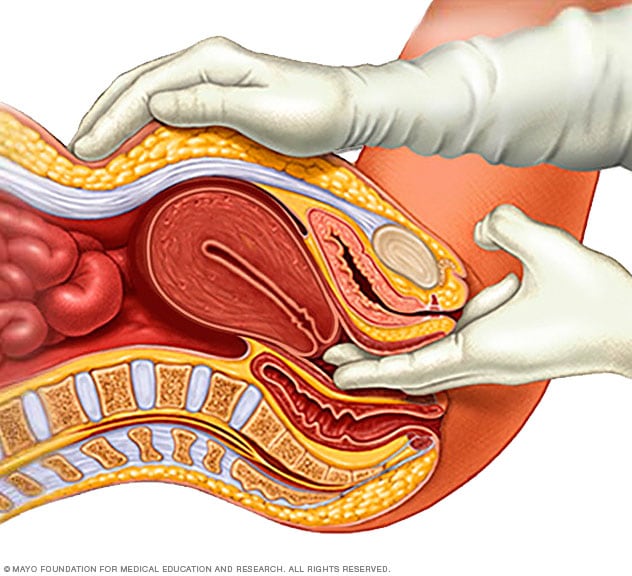 irregularities in the shape of your uterus, suggesting the presence of fibroids.
irregularities in the shape of your uterus, suggesting the presence of fibroids.
If you have symptoms of uterine fibroids, your doctor may order these tests:
- Ultrasound. If confirmation is needed, your doctor may order an ultrasound. It uses sound waves to get a picture of your uterus to confirm the diagnosis and to map and measure fibroids.
A doctor or technician moves the ultrasound device (transducer) over your abdomen (transabdominal) or places it inside your vagina (transvaginal) to get images of your uterus. - Lab tests. If you have abnormal menstrual bleeding, your doctor may order other tests to investigate potential causes. These might include a complete blood count (CBC) to determine if you have anemia because of chronic blood loss and other blood tests to rule out bleeding disorders or thyroid problems.
Other imaging tests
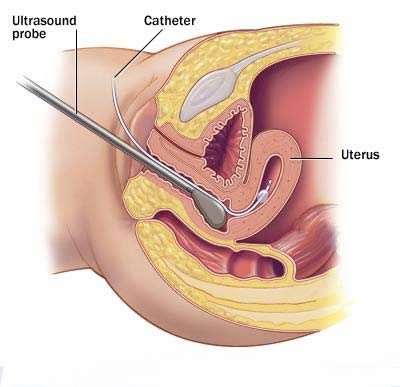
- Magnetic resonance imaging (MRI). This imaging test can show in more detail the size and location of fibroids, identify different types of tumors, and help determine appropriate treatment options. An MRI is most often used in women with a larger uterus or in women approaching menopause (perimenopause).
- Hysterosonography. Hysterosonography (his-tur-o-suh-NOG-ruh-fee), also called a
 saline infusion sonogram, uses sterile salt water (saline) to expand the uterine cavity, making it easier to get images of submucosal fibroids and the lining of the uterus in women attempting pregnancy or who have heavy menstrual bleeding.
saline infusion sonogram, uses sterile salt water (saline) to expand the uterine cavity, making it easier to get images of submucosal fibroids and the lining of the uterus in women attempting pregnancy or who have heavy menstrual bleeding. - Hysterosalpingography. Hysterosalpingography (his-tur-o-sal-ping-GOG-ruh-fee) uses a dye to highlight the uterine cavity and fallopian tubes on X-ray images. Your doctor may recommend it if infertility is a concern. This test can help your doctor determine if your fallopian tubes are open or are blocked and can show some submucosal fibroids.
- Hysteroscopy. For this exam, your doctor inserts a small, lighted telescope called a hysteroscope through your cervix into your uterus. Your doctor then injects saline into your uterus, expanding the uterine cavity and allowing your doctor to examine the walls of your uterus and the openings of your fallopian tubes.
Traditional fibroid treatment involves the removal of the uterus in a hysterectomy procedure or heavy dosages of medication to dissolve the benign, smooth muscle masses. Either option has severe consequences during the childbearing years, but now there are less invasive procedures and more natural ways.
Allopathic Treatment
Traditional allopathic fibroid treatment involves the removal of the uterus in a hysterectomy procedure or heavy dosages of drugs to dissolve the benign, smooth muscle masses. Either option has severe consequences during the childbearing years, but now there are less invasive procedures and more natural medicated ways for example Homeopathy.
Allopathic drugs for uterine fibroids target hormones that regulate menstrual cycle, treating symptoms such as heavy menstrual bleeding and pelvic pressure. But they don’t eliminate fibroids, but may shrink them. Medications include:
- Gonadotropin-releasing hormone (GnRH) agonists. Medications called GnRH agonists treat fibroids by blocking the production of estrogen and progesterone, putting you into a temporary menopause-like state. As a result, menstruation stops, fibroids shrink and anemia often improves.GnRH agonists include leuprolide (Lupron Depot, Eligard, others), goserelin (Zoladex) and triptorelin (Trelstar, Triptodur Kit).Many women have significant hot flashes while using GnRH agonists. GnRH agonists typically are used for no more than three to six months because symptoms return when the medication is stopped and long-term use can cause loss of bone.Your doctor may prescribe a GnRH agonist to shrink the size of your fibroids before a planned surgery or to help transition you to menopause.
- Progestin-releasing intrauterine device (IUD). A progestin-releasing IUD can relieve heavy bleeding caused by fibroids. A progestin-releasing IUD provides symptom relief only and doesn’t shrink fibroids or make them disappear. It also prevents pregnancy.
- Tranexamic acid (Lysteda, Cyklokapron). This nonhormonal medication is taken to ease heavy menstrual periods. It’s taken only on heavy bleeding days.
- Other medications. Your doctor might recommend other medications. For example, oral contraceptives can help control menstrual bleeding, but they don’t reduce fibroid size.Nonsteroidal anti-inflammatory drugs (NSAIDs), which are not hormonal medications, may be effective in relieving pain related to fibroids, but they don’t reduce bleeding caused by fibroids. Your doctor may also suggest that you take vitamins and iron if you have heavy menstrual bleeding and anemia.
Allopathic Noninvasive procedure
- A noninvasive treatment option for uterine fibroids that preserves your uterus, requires no incision and is done on an outpatient basis.
- Performed while you’re inside an MRI scanner equipped with a high-energy ultrasound transducer for treatment. The images give your doctor the precise location of the uterine fibroids. When the location of the fibroid is targeted, the ultrasound transducer focuses sound waves (sonications) into the fibroid to heat and destroy small areas of fibroid tissue.
- Newer technology, so researchers are learning more about the long-term safety and effectiveness. But so far data collected show that FUS for uterine fibroids is safe and effective.
Minimally invasive procedures
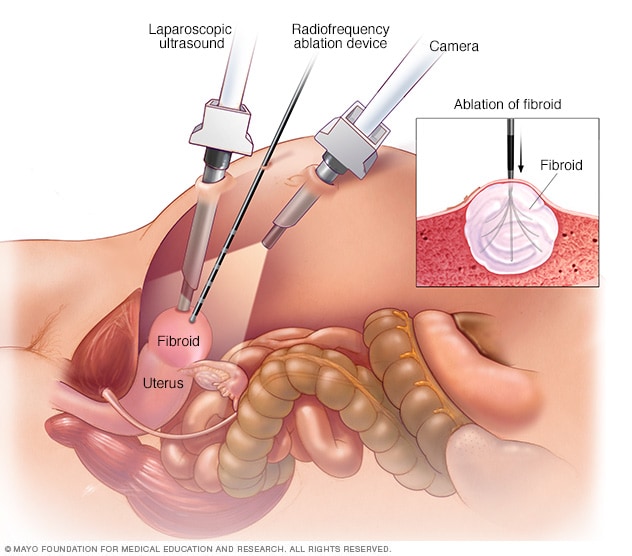 Certain procedures can destroy uterine fibroids without actually removing them through surgery. They include:
Certain procedures can destroy uterine fibroids without actually removing them through surgery. They include:
Uterine artery embolization
Small particles (embolic agents) are injected into the arteries supplying the uterus, cutting off blood flow to fibroids, causing them to shrink and die.This technique can be effective in shrinking fibroids and relieving the symptoms they cause. Complications may occur if the blood supply to your ovaries or other organs is compromised. However, research shows that complications are similar to surgical fibroid treatments and the risk of transfusion is substantially reduced.
Radiofrequency ablation
In this procedure, radiofrequency energy destroys uterine fibroids and shrinks the blood vessels that feed them. This can be done during a laparoscopic or transcervical procedure. A similar procedure called cryomyolysis freezes the fibroids.With laparoscopic radiofrequency ablation (Acessa), also called Lap-RFA, your doctor makes two small incisions in the abdomen to insert a slim viewing instrument (laparoscope) with a camera at the tip. Using the laparoscopic camera and a laparoscopic ultrasound tool, your doctor locates fibroids to be treated.After locating a fibroid, your doctor uses a specialized device to deploy several small needles into the fibroid. The needles heat up the fibroid tissue, destroying it. The destroyed fibroid immediately changes consistency, for instance from being hard like a golf ball to being soft like a marshmallow. During the next three to 12 months, the fibroid continues to shrink, improving symptoms.Because there’s no cutting of uterine tissue, doctors consider Lap-RFA a less invasive alternative to hysterectomy and myomectomy. Most women who have the procedure get back to regular activities after 5 to 7 days of recovery.
The transcervical — or through the cervix — approach to radiofrequency ablation (Sonata) also uses ultrasound guidance to locate fibroids.
Laparoscopic or robotic myomectomy
In a myomectomy, your surgeon removes the fibroids, leaving the uterus in place.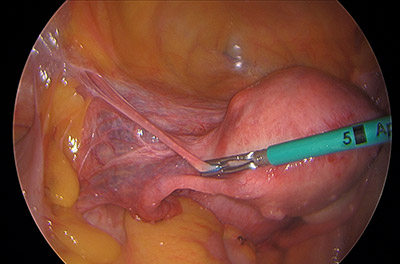 If the fibroids are few in number, you and your doctor may opt for a laparoscopic or robotic procedure, which uses slender instruments inserted through small incisions in your abdomen to remove the fibroids from your uterus.Larger fibroids can be removed through smaller incisions by breaking them into pieces (morcellation), which can be done inside a surgical bag, or by extending one incision to remove the fibroids.Your doctor views your abdominal area on a monitor using a small camera attached to one of the instruments. Robotic myomectomy gives your surgeon a magnified, 3D view of your uterus, offering more precision, flexibility and dexterity than is possible using some other techniques.
If the fibroids are few in number, you and your doctor may opt for a laparoscopic or robotic procedure, which uses slender instruments inserted through small incisions in your abdomen to remove the fibroids from your uterus.Larger fibroids can be removed through smaller incisions by breaking them into pieces (morcellation), which can be done inside a surgical bag, or by extending one incision to remove the fibroids.Your doctor views your abdominal area on a monitor using a small camera attached to one of the instruments. Robotic myomectomy gives your surgeon a magnified, 3D view of your uterus, offering more precision, flexibility and dexterity than is possible using some other techniques.
Hysteroscopic myomectomy
This procedure may be an option if the fibroids are contained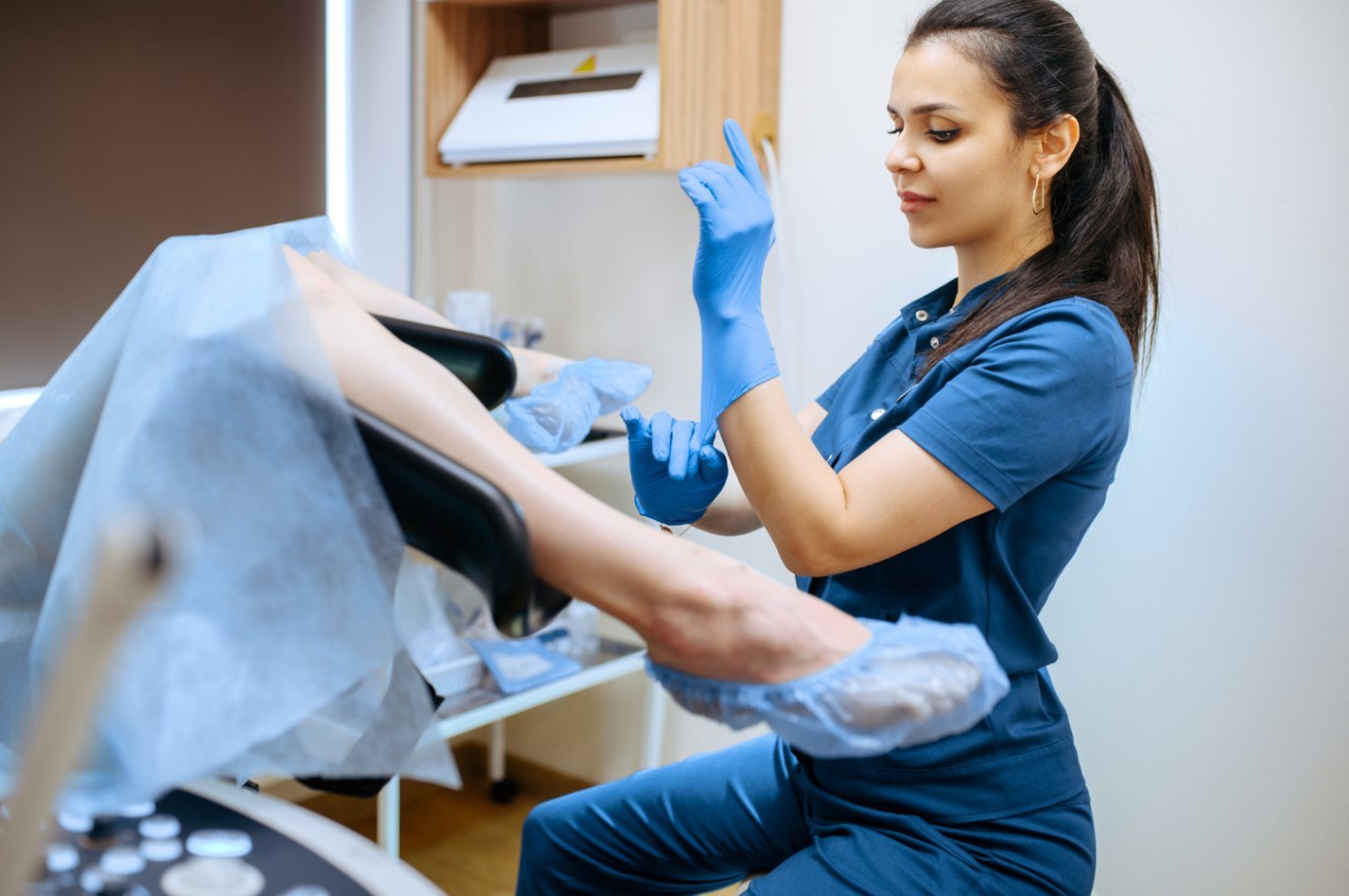 inside the uterus (submucosal). Your surgeon accesses and removes fibroids using instruments inserted through your vagina and cervix into your uterus.
inside the uterus (submucosal). Your surgeon accesses and removes fibroids using instruments inserted through your vagina and cervix into your uterus.
Endometrial ablation
This treatment, performed with a specialized instrument inserted into your uterus, uses heat, microwave energy, hot water or electric current to destroy the lining of your uterus, either ending menstruation or reducing your menstrual flow.Typically, endometrial ablation is effective in stopping abnormal bleeding. Submucosal fibroids can be removed at the time of hysteroscopy for endometrial ablation, but this doesn’t affect fibroids outside the interior lining of the uterus.Women aren’t likely to get pregnant following endometrial ablation, but birth control is needed to prevent a pregnancy from developing in a fallopian tube (ectopic pregnancy).
With any procedure that doesn’t remove the uterus, there’s a risk that new fibroids could grow and cause symptoms.
Traditional allopathic surgical procedures
Options for traditional surgical procedures include:
- Abdominal myomectomy. If you have multiple fibroids, very large fibroids or very deep fibroids, your doctor may use an open abdominal surgical procedure to remove the fibroids.Many women who are told that hysterectomy is their only option can have an abdominal myomectomy instead. However, scarring after surgery can affect future fertility.
- Hysterectomy. This surgery removes the uterus. It remains the only proven permanent solution for uterine fibroids.Hysterectomy ends your ability to bear children. If you also elect to have your ovaries removed, the surgery brings on menopause and the question of whether you’ll take hormone replacement therapy. Most women with uterine fibroids may be able to choose to keep their ovaries.
Morcellation during fibroid removal
Morcellation — a process of breaking fibroids into smaller pieces — may increase the risk of spreading cancer if a previously undiagnosed cancerous mass undergoes morcellation during myomectomy. There are several ways to reduce that risk, such as evaluating risk factors before surgery, morcellating the fibroid in a bag or expanding an incision to avoid morcellation.
All myomectomies carry the risk of cutting into an undiagnosed cancer, but younger, premenopausal women generally have a lower risk of undiagnosed cancer than do older women.
Also, complications during open surgery are more common than the chance of spreading an undiagnosed cancer in a fibroid during a minimally invasive procedure. If your doctor is planning to use morcellation, discuss your individual risks before treatment.
The Food and Drug Administration (FDA) advises against the use of a device to morcellate the tissue (power morcellator) for most women having fibroids removed through myomectomy or hysterectomy. In particular, the FDA recommends that women who are approaching menopause or who have reached menopause avoid power morcellation. Older women in or entering menopause may have a higher cancer risk, and women who are no longer concerned about preserving their fertility have additional treatment options for fibroids.
Risk of developing new fibroids after allopathic treatment
For all procedures except hysterectomy, seedlings — tiny tumors that your doctor doesn’t detect during surgery — could eventually grow and cause symptoms that warrant treatment. This is often termed the recurrence rate. New fibroids, which may or may not require treatment, also can develop.
Also, some procedures — such as laparoscopic or robotic myomectomy, radiofrequency ablation, or MRI-guided focused ultrasound surgery (FUS) — may only treat some of the fibroids present at the time of treatment.
Homeopathic Treatment for Uterine Fibroids (Permanent cure)
Terebinthina
Catamenia retarded and scanty. Drawing in thighs and colic as if menses would set in, a week after she had had them. Uterus and ovaries very painful. Ovarian dropsy. Terrible burning in uterus, with great bearing-down pain; caused great heat all over; craves drink; inward heat. Uterine diseases after wearing pessaries. Fibroids; bloody leucorrhoea; burning in uterus; menorrhagia, black blood. Herpes labialis. Abortion. Neuralgia during pregnancy. Burning and bearing down in uterus during urination. Metritis, lochia checked, burning in uterus. Peritonitis after confinement from tight-lacing.
Silica
Menses too early and too feeble, or else too profuse. Increased menses, with paroxysms of icy coldness over whole body. Suppression of the menses. Discharge of blood before proper period; menses too late; protracted; blood acrid. Metrorrhagia. Diarrhoea, before the menses. During the menses, pains in the abdomen, pale appearance of objects, or burning sensation and excoriation in vulva. Itching in the vulva. Pressing-down feeling in vagina. Itching, burning, and soreness in pudenda; during menses.
Discharge of blood from the uterus, while suckling. Abortion. Leucorrhoea, which flows when urinating, or after the menses. Leucorrhoea, like milk, flowing at intervals, and preceded by gripings in umbilical region. Acrid, corrosive leucorrhoea. Inflammation of nipples.
Thlaspi Bursa Pastoris
Uterine fibroids with prolonged menses (10-15 days). Menses appear very frequently. The next menstrual cycle appears even before recovery from the periods has occurred. Menstrual bleeding is profuse, with the presence of large clots. Violent uterine colic. Cramping pain in the uterus during menstruation in uterine fibroids cases.
Helonias
Loss of sexual desire and power with or without sterility. Profound melancholy, deep, undefined depression, with a sensation of soreness and weight in the womb; “a consciousness of a womb”. Aching, dragging weakness in sacral region, with prolapsus; also at climaxis, with marked debility, profound mental gloom. Prolapsus uteri and ulceration of the cervix; discharge constant, dark, badly smelling; flooding on lifting a weight, and on least exertion; great vaginal irritation.
Uterus low down, fundus tilted forwards; the finger passes with difficulty between the os and the rectum. Menses too frequent and profuse in women who are feeble from loss of blood. Flow passive: dark, coagulated, offensive. Leucorrhoea, with atony and anaemia.
Threatened abortion from atonic conditions. Scanty menstrual flow with heaviness, languor, drowsiness, and albuminous urine. Profuse flooding, with serous leucorrhoea, much uterine and ovarian pain; climaxis. Labia and pudendum hot, red, swollen, burning and itching terribly; epidermis every morning falls off in thin, transparent exfoliation.
Mucous surface of labia red, swollen, covered with a curdy deposit, like aphthae. Threatened abortion; habitual abortion. Albuminuria during pregnancy; great weakness, drowsiness.
Calcarea Carb
Catamenia premature and too copious. Sterility, with catamenia too early, and too profuse. Before the catamenia, mammae swollen and painful, fatigue, headache, disposition to be frightened, colic, and shivering.
During the catamenia, congestion in the head, with internal heat, or cuttings in the abdomen, and cramp-like pain in the lumbar region, or else vertigo, headache, toothache, nausea, colic, and other sufferings.
Suppressed menstruation, with full habit. Miscarriage. Voluptuous sensation in the genital parts, with emission. Flow of blood at a time different from the catamenia. Metrorrhagia. Itching or pressing in the vagina. Shootings in the orifice of the matrix, and pressive pain in the vagina. Prolapsus uteri, with pressure on the parts. Itching in the womb. Inflammation and swelling of the womb, with redness, purulent discharge, and burning pain. Varices in the labia majora. Leucorrhoea before the catamenia. Leucorrhoea, with burning itching, or else like milk, flowing by fits, and during the emission of urine.
Sepia Officinalis
Pelvic organs relaxed. Bearing-down sensation as if everything would escape through vulva, must cross limbs to prevent protrusion, or press against vulva. Leucorrhoea yellow, greenish; with much itching. Menses Too late and scanty, irregular; early and profuse; sharp clutching pains. Violent stitches upward in the vagina, from uterus to umbilicus. Prolapse of uterus and vagina. Morning sickness. Vagina painful, especially on coition.
Thuja Occidentalis
Vagina very sensitive. Warty excrescences on vulva and perineum. Profuse leucorrhoea; thick, greenish. Severe pain in left ovary and left inguinal region. Menses scanty, retarded. Polypi; fleshy excrescences. Ovaritis; worse left side, at every menstrual period. Profuse perspiration before menses.
Ustilago Maydis
Vicarious menstruation. Ovaries burn, pain, swell. Profuse menses after miscarriage; discharge of blood from slightest provocation; bright red; partly clotted. Menorrhagia at climaxis. Oozing of dark blood, clotted, forming long black strings. Uterus hypertrophied. Cervix bleed easily. Postpartum haemorrhage. Profuse lochia.
Berberis Vulgaris
Tardy enjoyment in women, during coition, and often accompanied with incisive or shooting pains. Sensation of burning and excoriation in the vagina, extending to the labia. Pale catamenia, composed of serous blood. Menses, consisting of grey mucus or brown blood. Suppressed menstruation. During the catamenia, pains in the genital parts and in the loins, or violent pains in the head, with sensation of fainting. Catamenia insufficient, with acute drawing pains in the whole body, painful inflation of the abdomen, pain in the loins, shootings in the chest, dejected aspect, with violent pains in the head; or with ill-humour, disgust of life, dejection, smarting pains in the vagina, sensation of burning and excoriation in the anus, and pains in the arms, as far as the shoulders and the nape of the neck.
Sabina Officinalis
In the case of menstrual bleeding with clots in uterine fibroid cases, Sabina Officinalis is a significant medicine. The slightest motion increases menstrual bleeding. Pain from sacrum to pubis is another attending feature. During menses, pain in the uterus may be present that gets better by lying on the back. Uterine pain may extend to the thighs. Other symptoms include foul, acrid, corrosive, yellow leucorrhoea.
Kreosotum
Corrosive itching within vulva, burning and swelling of labia; violent itching between labia and thighs. During menses, difficult hearing; buzzing and roaring; eruption after. Burning and soreness in external and internal parts. Leucorrhoea, yellow, acrid; odor of green corn; worse between periods. Haemorrhage after coition. Menses too early, prolonged. Vomiting of pregnancy, with ptyalism. Menstrual flow intermits; ceases on sitting or walking; reappears on lying down. Pain worse after menses. Lochia offensive; intermits.
Fraxinus Americana
Uterus enlarged, and patulous. Watery, non irritating leucorrhoea. Fibroids with bearing-down sensation, cramping in feet, worse in afternoon and night. Dysmenorrhoea.
Janosia Ashoka
Leucorrhoea, Amenorrhoea, Metrorrhagia, Menorrhagia, Uterine colic, Urinary Tract Infections, Hemorrhoids with obstinate constipation, Reflex headaches arising due to uterine pathology; unilateral, Irritable and thickened bladder, Disturbed sleep with dreams of travelling. Uterine pathology associated with pain along the spine radiating to abdomen and thighs. Gastric complaints such as desire for sweets, also acid things. Thirsty, excessive nausea
Hemorrhoids with obstinate constipation, Reflex headaches arising due to uterine pathology; unilateral, Irritable and thickened bladder, Disturbed sleep with dreams of travelling. Uterine pathology associated with pain along the spine radiating to abdomen and thighs. Gastric complaints such as desire for sweets, also acid things. Thirsty, excessive nausea
Trillium Pendulum and Kali Carbonicum
In uterine fibroid cases with back pain during the menstrual cycle, Trillium Pendulum comes highly recommended. The pain may radiate to the hips from the back during menses. Tight binding of the back and hips provides relief. Menstrual bleeding is bright red and gushing. The slightest movement worsens uterine bleeding. Trillium Pendulum is also indicated for inter-menstrual bleeding every two weeks. Another attending feature is faintness from uterine bleeding. Kali Carbonicum is selected when there is violent back pain during menses. The pain gets better from sitting and pressure. The menstrual flow is also copious.
Erigeron Canadensis
Erigeron Canadensis is a beneficial medicine for treating frequent urination in case of uterine fibroids. In some cases, painful urination may also arise. The attending features are excessive menstrual bleeding which is bright red in colour. Erigeron Canadensis is also used for inter-menstrual bleeding from slight exertion.
Hepar Sulphuricum
Excoriation of the vulva, and between the thighs. Congestion of blood to the uterus. Irritation of ovaries; with swelling; and great sensitiveness. Discharge of blood between the periods, with inflation of the abdomen. Catamenia too long delayed, and diminished. Leucorrhoea, with smarting at the vulva. Cancerous ulcer on the breast, with stinging-burning of the edges, smelling like old cheese. Itching nipples.
China Officinalis and Ferrum Met
Both China Officinalis and Ferrum Met are effective medicines for treating uterine fibroids with heavy bleeding and anaemia. Among them, China Officinalis works best when there is profuse, dark menstrual bleeding, clots in menstrual blood, exhaustion and anaemia. Fainting spells may also arise. Ferrum Met is best used where the symptoms include pale, watery, heavy and prolonged menses leading to anaemia. Menstrual flow worsens from the slightest movement. Lower back pain or abdomen pain during menses may be observed.
Apis Melifestida
Amenorrhoea or menorrhagia. Inflammation, induration, swelling, and dropsy of the ovaries. Weight and pain in either ovarian region. Enlargement of the ovary with pain, Sharp, cutting, stinging pain in the swollen worse during menstruation. Ovarian tumours, with stinging pains like bee-stings.
Metritis, peritonitis, with stinging, thrusting pains. Pressing-down pain in the uterus. Bearing-down, with sensation as before menses. Dropsy of the ovaries; dropsy of the uterus. Menstruation suppressed or diminished, with congestion to the head.
Labour-like, bearing-down pains, followed by dark, bloody mucus. Threatened miscarriage in the early months, with heaviness of the abdomen, restlessness, and yawning. Abortion. Abortion during the early months. Dropsy in the latter part of pregnancy attended with puerperal convulsions. Ulceration and engorgement of os uteri. Large and painful swelling of the labia, with heat and stinging pains. Erysipelatous inflammation of the breasts. Swelling and hardness of the mammae threatening to ulcerate. Scirrhous or open cancer of the mammae, with stinging, burning pains.
Lilium Tigrinum
Menses early, scanty, dark, clotted, offensive; flow only when moving about. Bearing down sensation with urgent desire for stool, as though all organs would escape. Ceases when resting. Congestion of uterus, prolapse, and anteversion. Constant desire to support parts externally. Pain in ovaries and down thighs. Acrid, brown leucorrhoea; smarting in labia. Sexual instinct awakened. Bloated feeling in uterine region. Subinvolution. Pruritus pudendi.
For consultation, about your uterine fibroids, pain, there types, and Treatment, Diet etc; visit our clinic.
To order medicine by courier, please send your details at WhatsApp– +92319884588
 Dr Sayyad Qaisar Ahmed (MD {Ukraine}, DHMS, Isl. Jurisprudence); Works at “senior research officer Dnepropetrovsk state medical academy Ukraine”; is a leading Homeopathic physician practising in
Dr Sayyad Qaisar Ahmed (MD {Ukraine}, DHMS, Isl. Jurisprudence); Works at “senior research officer Dnepropetrovsk state medical academy Ukraine”; is a leading Homeopathic physician practising in
Al-Haytham clinic Risalpur. K.P.K, Pakistan.
(0923631023, 03119884588), K.P.K, Pakistan.
https://www.youtube.com/channel/UCkGaAWzzMmTk3Ua-Wu0TA_A
https://www.facebook.com/dr.qaisar.dixecosmetics
https://www.dixecosmetics.com/
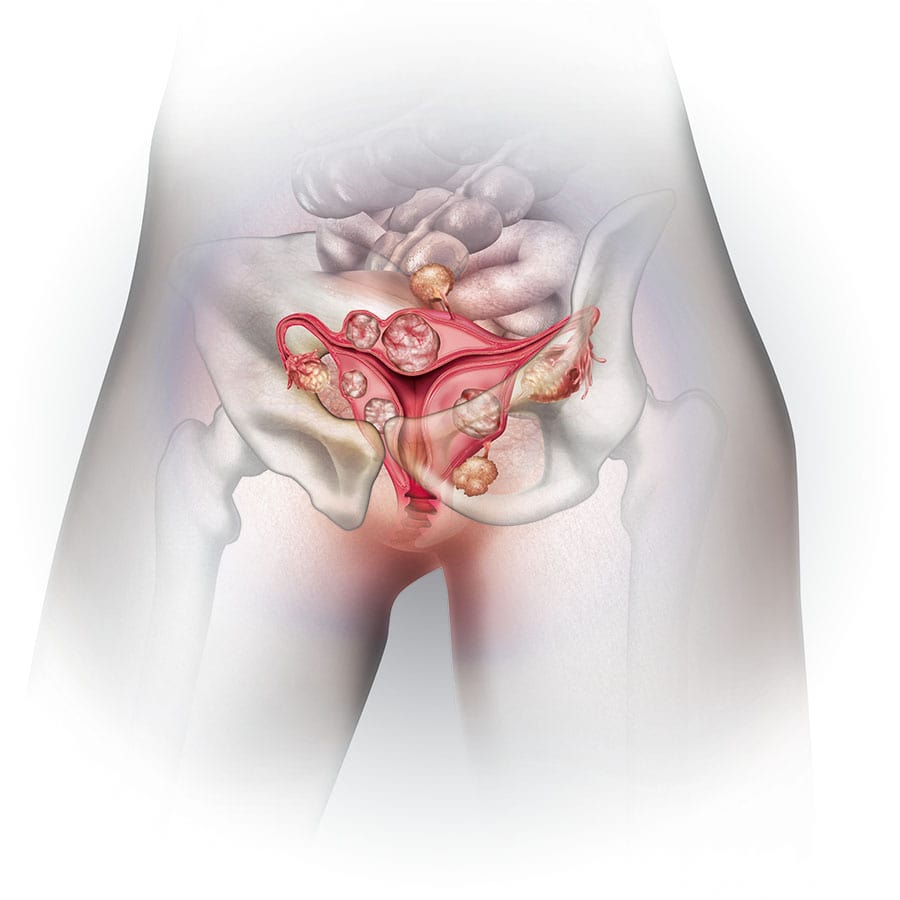
Comments are closed.